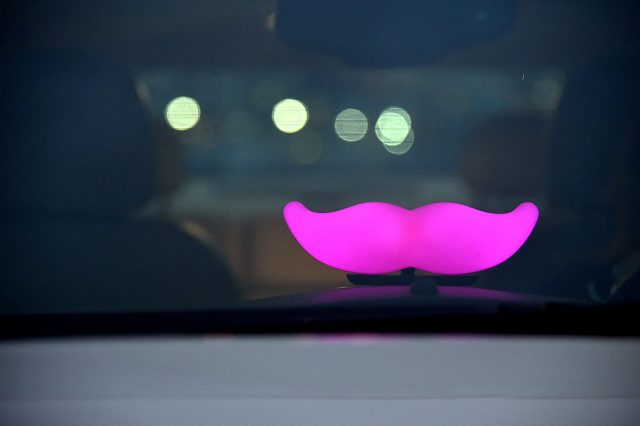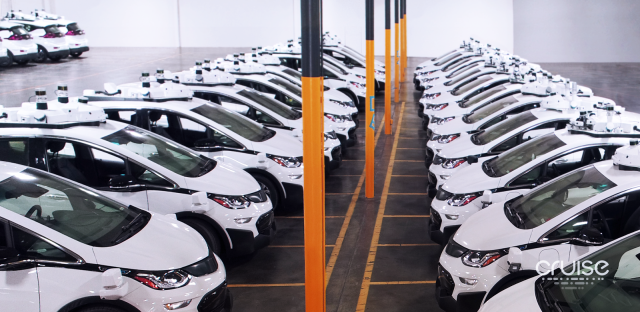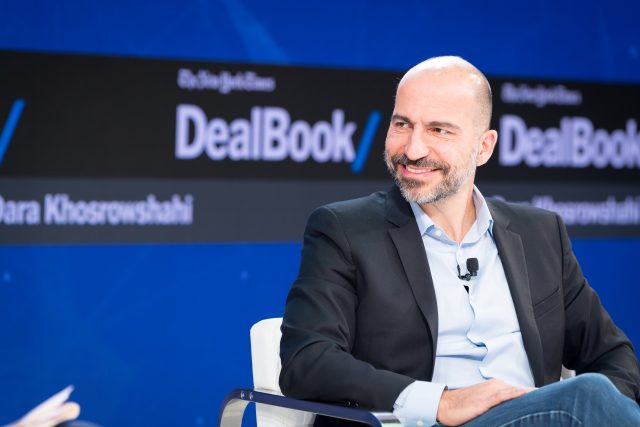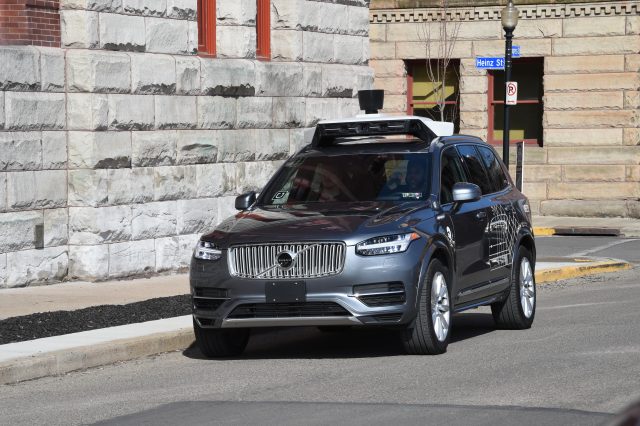Last week, an Uber self-driving car struck and killed pedestrian Elaine Herzberg in Tempe, Arizona. Then on Friday, The New York Timesly reported that the self-driving car program "was not living up to expectations" even before last week's crash. The cars "were having trouble driving through construction zones and next to tall vehicles," the Times said.
Uber halted testing nationwide last week. Now Arizona Gov. Doug Ducey has announced that he is seeking to "suspend Uber's ability to test and operate autonomous vehicles" in Arizona. Given the huge challenges facing the project—and Uber as a whole—Uber CEO Dara Khosrowshahi should consider a drastic remedy: sell off the project to another company.
Reaching commercial viability could easily require several more years of steady funding, and it's not clear if Uber can provide that. In 2017, Uber lost more than $1 billion per quarter, and at its current burn rate the company will run out of money in 2019 if it can't raise more. That's a problem because it's far from clear the company's driverless car technology will be ready for a commercial launch by then. The tight financial situation could create pressures to rush Uber's self-driving car technology into the marketplace before it's ready.
More fundamentally, the project needs to earn back the public trust after last week's fatal crash. That's going to be hard to do if the project remains under the corporate umbrella of Uber, a company that doesn't have the best reputation for honesty and respect for the rules. Selling the project to a new owner could give it a fresh start in the public mind.
The most attractive suitors here are likely to be conventional car companies. They have significant financial resources and the staying power to fund the project for as long as it takes to get the technology right. More important, car companies generally have safety-oriented cultures with engineers used to coloring inside the lines. A car company would be good at making sure that the team is taking all appropriate safety measures—and also at convincing the public that the vehicles can be trusted.
Uber doesn't need its own self-driving cars

Former Uber CEO Travis Kalanick launched the driverless project because he saw driverless car technology as an existential threat to Uber. He believed that if a rival like Google developed driverless cars before Uber did, they'd be able to undercut Uber's prices and ultimately drive Uber out of business.
But there's reason to doubt this is true.
It does look like Waymo will bring its cars to market before Uber or anyone else. But once it introduces the first vehicle, that doesn't mean it's game over for Uber. It will take years—possibly decades—for Waymo to manufacture the cars and collect the map data required to dominate major markets nationwide.
And as it expands into a new city, it'll have to drum up business for the new service, luring customers away from conventional ride-sharing services. Uber will also face situations where it is able to serve some customers and routes but not all of them—either because it doesn't have enough cars yet or because it hasn't mapped every area customers want to go.
And this means that conventional ride-hailing networks will have a lot to offer fledgling self-driving car companies. Ride-hailing networks can help driverless carmakers immediately find customers for the cars and routes they have available, while supplying a conventional human-driven car for other routes—ensuring customers get a good overall experience.
Lyft has recognized this opportunity and has positioned itself to be a middleman for a wide variety of self-driving taxi providers. Waymo and Cruise may try to build their own ride-sharing networks from scratch. But companies that arrive in the marketplace later will be in a hurry to expand their market share rapidly—the huge customer bases Uber and Lyft already have will be a big asset here.
Lyft's strategy seems perfectly viable for Uber as well. If Uber focuses on building its own self-driving car technology, then its future depends on beating other companies at developing self-driving technology. On the other hand, if Uber focuses on being an open platform for other companies to offer driverless taxis, then it has the potential to succeed regardless of who wins the driverless car race. It simply needs to convince companies to use Uber's ride-sharing network rather than building one from scratch.
Indeed, there's a risk that by developing proprietary self-driving cars, Uber will discourage other companies from offering their own self-driving cars on Uber's network. Lyft seems to be mindful of this risk; it is also working on self-driving car technology, but it is specifically positioning it as a technology stack it can license to third parties wanting to offer services on Lyft's network.
Uber can't afford an open-ended commitment to driverless cars

The conventional Silicon Valley approach to technology development is what Facebook CEO Mark Zuckerberg used to call "move fast and break things." A website can't run people over, so it made perfect sense that Internet companies are used to introducing half-finished products into the marketplace and then iterating rapidly based on feedback from users.
Obviously, this approach won't work for self-driving cars. Companies need to keep refining and testing their vehicles until they're confident there is a very low error rate—before they introduce them into the marketplace. One consequence of this is that the time required to finish work on a driverless car project is unpredictable and potentially quite long.
That isn't a problem for Waymo, whose parent company has an essentially unlimited stream of Google profits to reinvest. It's also not a problem for Cruise, whose parent company General Motors is used to spending billions of dollars on research and development.
But it's a big problem for Uber, which lost more than $1 billion per quarter in 2017. Uber had $6.6 billion in the bank in mid-2017 and got $1.25 billion from Softbank in late 2017—but that still means Uber is on track to run out of money some time in 2019. The company has been working to cut its losses and can probably stretch that money out for another year or two. But this is not a company that can comfortably make an open-ended commitment to funding self-driving car research for as long as it takes to get it right.
Until recently, Uber's losses weren't a problem because Uber was able to raise seemingly unlimited amounts of new money. But a series of brutal scandals in 2017 changed that. Last fall's $1.25 billion cash infusion came on less generous terms than the previous round—suggesting that investors are starting to grow more wary of the company. If Uber doesn't show progress toward profitability, investors will demand even harsher terms in future rounds, and eventually they'll just shut their checkbooks altogether.
And as Uber starts to run out of money, it will face stronger temptations to cut corners in order to get its self-driving cars to market faster.
Also, the simple fact is that it's going to be a challenge for Uber to reach profitability even without a self-driving car project. Dumping the project—and hopefully getting some cash in exchange—would give the rest of the company some much-needed breathing room.
Khosrowshahi has a lot of other issues to worry about

A temptation to cut corners is particularly worrying because Uber has a win-at-any-cost culture inherited from two departed Uber executives: former CEO Travis Kalanick and Anthony Levandowski, who led the company's self-driving car efforts between 2016 and 2017.
Under Kalanick's leadership, the company suffered a series of scandals, from accusations of widespread sexual harassment in the office to revelations that the company had a special version of its software specifically designed to mislead city regulators trying to enforce taxi laws against Uber vehicles.
Meanwhile, emails unearthed during Uber's recent lawsuit with Waymo revealed that Levandowski has been dismissive of safety concerns since his days as a senior engineer at Google.
"We don't need redundant brakes & steering or a fancy new car; we need better software," wrote engineer Anthony Levandowski to Alphabet CEO Larry Page in January 2016. "To get to that better software faster we should deploy the first 1000 cars asap. I don't understand why we are not doing that. Part of our team seems to be afraid to ship." In another email, he wrote that "the team is not moving fast enough due to a combination of risk aversion and lack of urgency."
Not long afterwards, Levandowski left Google to start a new company, Otto, which was quickly acquired by Uber. Levandowski was put in charge of Uber's driverless car project, leading to a series of confrontations with regulators in California.
Kalanick and Levandowski have both left the team, but corporate cultures are sticky. These kinds of attitudes are likely to linger at Uber—and within the driverless car program in particular—unless Khosrowshahi makes a concerted effort to root them out.
The problem is that Khosrowshahi already has his work cut out for him fixing other aspects of Uber. Uber lost at least a dozen high-level executives amid the chaos of last year's scandals and Kalanick's departure. When Khosrowshahi took over last August, Uber was facing three federal criminal investigations on unrelated scandals. Uber has a lot of work to do to change its misogynistic culture and repair its public image on issues of gender equality. And, of course, Khosrowshahi needs a strategy to make Uber's perpetually money-losing core business profitable.
Nurturing a disciplined safety-oriented culture in Uber's ride-sharing division would be a challenging job even if it were Khosrowshahi's top priority—and it won't be.
Being owned by a car company could help Uber's self-driving car team

Given all of the above arguments, it's tempting to argue that Uber should just shut its self-driving car program down. But that would be a mistake. The project has a lot of valuable assets, including a bunch of talented engineers, a fleet of self-driving vehicles, and valuable data gathered over more than 2 million miles of real-world tests. And while the team seems to be behind Waymo and possibly GM's Cruise, it's still one of the more sophisticated driverless car projects on the planet.
A car company would likely be a good choice for a new corporate parent for the project. Car companies have the financial resources to fund a project like this for as many years as it takes to get it right. More importantly, years of building cars gives them a methodical, safety-oriented culture. They could bring some much-needed discipline to Uber's development efforts.
The obvious point of comparison here is Cruise, a startup General Motors bought in 2016. At the time of the sale, I worried that GM's bureaucracy would strangle Cruise's innovative culture. But that doesn't seem to have happened. Cruise has emerged as the strongest rival to industry leader Waymo.
Waymo itself is another interesting point of comparison. When Levandowski complained about "risk aversion" in Google's self-driving car project in early 2016, he may have been thinking about John Krafcik, who had recently taken over Google's self-driving car project and is now CEO of Waymo. Krafcik comes from the auto industry, having previously served as CEO of Hyundai. Frustration with the slow pace of progress under Krafcik contributed to a wave of departures from the Google self-driving car project in 2016, but, under Krafcik's leadership, Waymo has avoided any major safety incidents and looks like it's still on track to launch a commercial product well ahead of any competitors.
Moreover, Waymo has been learning that it's difficult to rapidly scale up a driverless taxi service if you're not a car company. Waymo has signed a series of deals with Fiat Chrysler to supply Chrysler Pacifica minivans. But acquiring and retrofitting these vehicles has been a laborious process. In 2016, Waymo discussed a manufacturing deal with Ford, but The Information's Amir Efrati reports that Waymo's partnership with Ford "fell apart because Waymo (then still part of Google) didn't want to front some of Ford's cost to expand manufacturing capacity to eventually produce thousands or potentially millions of electric light-passenger vehicles that would be powered by Google software."
Waymo ordered "thousands" of Pacifica minivans from Chrysler in January. Uber, whose technology is well behind Waymo's, seems to be taking a more aggressive approach, ordering 24,000 vehicles from Volvo last November. Delivery is scheduled to start next year.
That big order could save Uber precious months getting to market if its technology is ready in time. But it will become a massive liability if the technology isn't ready. Plus, Uber could discover that it's harder than it expected to integrate Uber's sensors and computing hardware into the Volvo vehicles.
Being owned by a car company would sidestep all of these issues. The project's new corporate parent could provide as many cars as it needed without having to haggle for them. More important, the car company's production engineers could work closely with the self-driving car team to build cars designed from the ground up for driverless operation—something Cruise and GM engineers are doing already.
The most obvious suitor here is Volvo. The company already has several years of experience working with Uber, and it has been scaling back its own self-driving car efforts in recent months. A deal with Volvo would save Uber from the problems it will otherwise encounter if those 24,000 cars arrive before Uber is ready for them.
But other companies could be a good fit. Fiat Chrysler has been supplying minivans to Waymo, but no larger partnership between the companies has been announced so far. Honda is a big car company whose self-driving technology efforts have been rated as lackluster so far.
There's a real risk that having an automaker as a corporate parent would make Uber's self-driving car team too bureaucratic. Cruise undoubtedly owes some of its success to the strong personality of Cruise CEO Kyle Vogt, who has insisted on retaining substantial autonomy and a lot of input into broader strategic decisions at GM. There's no one like him running Uber's self-driving car project, so there's a risk that it might not have strong leadership.
But the project doesn't seem to have great prospects inside Uber either. Becoming part of a car company could allow the project to turn over a new leaf.
[contf] [contfnew] 
Ars Technica
[contfnewc] [contfnewc]







